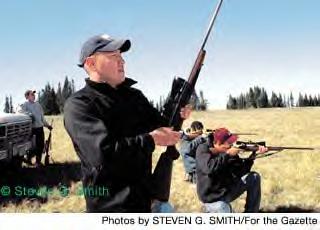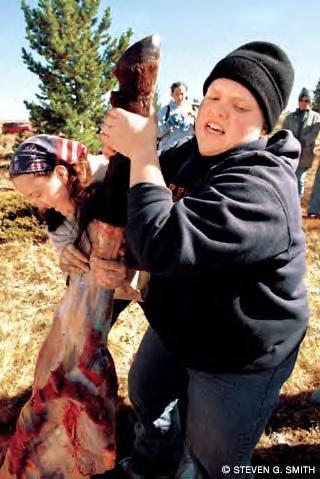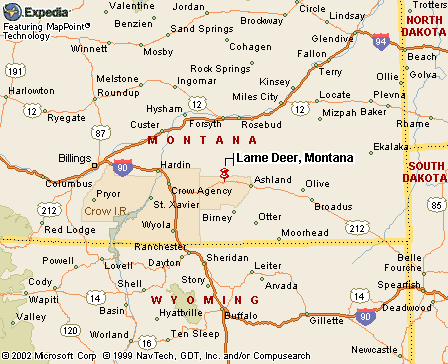|
|
Canku Ota |
|
|
(Many Paths) |
||
|
An Online Newsletter Celebrating Native America |
||
|
October 4, 2003 - Issue 97 |
||
|
|
||
|
Students Hunt Bison as Part of Cross-Cultural Experience |
||
|
by Brett French Billings Gazette Oudoor Writer |
||
|
credits: Photos by Steven G. Smith |
|
In the deep blue sky, a lone cloud - its downy mass furrowed as if vibrated into sections by the herd's hammering hooves - overlooks the curious gathering below. Solomon Little Owl firmly sets his Nike-clad feet in the dry grass, raises the 7mm magnum hunting rifle to his shoulder and takes aim through the telescopic sight. Behind him, a crowd of about 50 people strain to see, some standing in the back of pickups, others spread across the hillside for a better view. In silence they wait for the crack of the rifle shot and for one of the bison to fall.
Saturday was the seventh annual buffalo hunt organized by the Native American Student Services department at the University of Northern Colorado in Greeley. The hunt is held in the Bighorn Mountains on the Crow Indian Reservation in south-central Montana. The program is a way to introduce Crow culture to university students, as well as the Crow to the university. The three-day trip, which included visits to the Little Bighorn Battlefield and the Bighorn Canyon National Recreation Area, is capped by a buffalo hunt. Students are encouraged to take part in the butchering of the animals killed by tribal members. Little Owl, 30, who grew up on the reservation, is the director of UNC's Native American Student Services. He said the trip offered students a chance to see another side of Native American life. "We're trying to breach a cultural gap," Little Owl said. "A lot of these kids will never go camping, never go to Montana. This is a lifetime experience. "But it's also a recruiting trip for the Crow, to let them know the benefits of a college education," he said. Although the trip is billed as a buffalo hunt, Little Owl uses the experience as a way to separate reality from myth. He said that after the hunt, students will realize that hamburger doesn't come from McDonald's and that Native Americans do not act like those depicted in the movie "Dances With Wolves." The events affect the students in many ways. For 20-year-old Aubrey Nitzberg, the trip has connected her to a past she did not know. "It's more than just a buffalo hunt," she said. Nitzberg said she has Native American ancestors from the Southern Ute, Shoshone, Blackfeet and Cherokee tribes. But until she made her first trip with Little Owl, she felt disconnected from her roots. "There's something soothing about the trip," she said. "I feel like it's home, even though it's not my home. I feel like they are my traditions, even though they are not my own. I feel lucky that they are sharing this with me. It's magical." Since her first trip three years ago, she has become involved in Native American Student Services. She is now the president of First Nations, a student organization.
The bison are too bunched up for Little Owl to make a clean kill. The herd pushes through the meadow into the timber and crosses a ridge beyond. In a pickup driven by a tribal member, Little Owl and a few students pursue the herd, hoping to get a shot. Crow game warden Curtis Rides Horse drives behind in a pickup packed with students who are hoping to see the kill and help butcher the meat. "This is so cool," 21-year-old Kristina Chadwick coos as she bounces along. "This is what we came here for. I'm so excited." As the herd slows atop a hill, Little Owl gets a chance to shoot. The rifle report echoes across the mountains. Two more shots and a 3-year-old cow moves away from the now-running herd. She walks into a patch of scattered timber and old downfall as the hunters approach. A final shot at close range finally kills the prostrate cow. As pickups pull up to the site, students jump down and gather around the dead bison while others tend to a bull killed at the top of the canyon. Some of the students take pictures. Some smile. Others look sad or seem worried. There is little talk. But quickly, the hard work of butchering begins.
Chadwick pulls up the sleeves of her flowered cotton top and latches on to one of the cow's hairy legs as the animal is gutted. Before long she has a splotch of blood smeared on her forehead, just above her wraparound sunglasses. Chadwick, of Craig, Colo., later said her town wouldn't survive if it wasn't for hunting and coal mining. And although her parents hunted when she was younger, she has never been on a hunt when an animal was killed. Steam rises from the chest cavity after the cow is cut open by a sharp knife and saw. Students help pull the entrails out. Working quickly, Little Owl then skins one side of the bison and begins cutting the meat into quarters - the rear leg is separated from the backbone, then the front leg. The backstraps are peeled away. Students struggle to lift the heavy slabs of meat which are placed on a plastic tarp to keep them free of dirt. Kim Rusho, 19, of Denver, watches the work from a distance, a camera in her hand. "At first it was a shock," she said. "I've never seen an animal die. But after a while, you just see it as meat. "I think it's good for people to experience something like this, even if it is hard," she adds. "We have to see the sacrifice that's made. It's not always convenient to feed yourself." |
|
|
www.expedia.com |
|
|
||
|
|
||
| Canku Ota is a free Newsletter celebrating Native America, its traditions and accomplishments . We do not provide subscriber or visitor names to anyone. Some articles presented in Canku Ota may contain copyright material. We have received appropriate permissions for republishing any articles. Material appearing here is distributed without profit or monetary gain to those who have expressed an interest. This is in accordance with Title 17 U.S.C. Section 107. | ||
|
Canku Ota is a copyright © 2000, 2001, 2002, 2003 of Vicki Lockard and Paul Barry. |
||
 |
 |
|
|
The "Canku Ota - A Newsletter Celebrating Native America" web site and its design is the |
||
|
Copyright © 1999, 2000, 2001, 2002, 2003 of Paul C. Barry. |
||
|
All Rights Reserved. |
||
 LAME
DEER - On the western flank of Black Canyon, 100 head of bison
shuffle uphill and turn across an open meadow.
LAME
DEER - On the western flank of Black Canyon, 100 head of bison
shuffle uphill and turn across an open meadow. "All
right you guys, help out," Little Owl yells to the group.
"All
right you guys, help out," Little Owl yells to the group. 